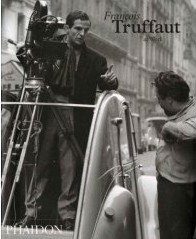
'Francois Truffaut At Work' By Carole Le Berre
London: Phaidon Press, 2005. ISBN 0 7148 4568 X 319pp. (hardback)
£39.95
The next best thing to discovering hitherto unknown works of art by
someone you intensely admire is unearthing material about them you
never knew existed. Thus it is that Carole Le Berre's substantial
volume Francois Truffaut At Work starts from an already
winning position. (Admittedly, this is helped by Truffaut himself, who,
as Le Berre remarks 'had loved, indeed relished, preserving
everything', p.9). It is on the one hand the sheer variety of material
that Truffaut kept that makes Le Berre's book such an interesting
addition to the director's canon. On the other, the way the author uses
the material is also worthy of note, as she blends very disparate
elements together to create a continually interesting patchwork quilt
of the process of creation- what was excluded in Truffaut's
films becomes as fascinating a topic as what was included.
Throughout Francois Truffaut At Work , Le Berre's policy is
an ardently sensible one as she follows Truffaut's career in
chronological order, using his primary source material to highlight
issues in casting, script changes and events that took place during
filming. It is this approach that enables an extra layer of knowledge
to be gleaned regarding a film one thought one knew well- the
multiplicity of titles for what eventually became Les Quatre Cents
Coups (1959) for example (p.20), and the matters surrounding the
casting of Truffaut film legend Jean-Pierre Leaud in the same film.
It is the way Le Berre's book offers priviliged access to documents not
normally open to public scrutiny which is perhaps its greatest
selling-point. In essence, studying the book becomes like moving from a
guided tour of stiffly-posed family photographs chosen at your hostess'
whim to viewing rather more interesting candid shots when your hostess
has temporarily departed to make un encore du cafe in a
rather distant kitchen. It is the sense of intimacy and looking in on a
distinctly private visual history of Truffaut's films which is as
wonderful as the anecdotal history provided alongside the images. Thus,
the many splendid candid shots of the crew in action (pages 100 and 111
for example) add a vibrant spontaneity to the story of the film-making
process which would be hard to replicate with stills from the released
films. The double-page spreads that contrast shooting script (with
marked changes) and stills from the film (cf. page 103 and others) also
provides a sumptuous feast for the eyes.
The book closes with a detailed page of biographical notes and a
filmography which provides a precis of each film together
with technical details of cast and crew. It is an appropriately
effective way to round off a book that, from the fascinating front
cover shot of Truffaut avec camera to the iris-like title
page for the section on each film and finally the end-papers (which
show the film crew shooting the famous finale of Les Quatre Cents
Coups , absorbs, delights and intrigues.
Francois Truffaut At Work is potentially a new phenomenon-
yes, it is a coffee-table book, but it is much, much more than that.
Like the French, this adjunct of the coffee-table world is
sophisticated, refined and continually interesting, revealing its
subject as a man dedicated to his craft. It is the way Francois
Truffaut made cinema his vocation that comes across most strongly from
Le Berre's book, a publication that itself was obviously a vocation for
its author. Whether you have merely seen Truffaut's films, own them on
DVD or are an aficianado par excellence, the opportunity to
understand more about the man behind them and his way of working should
be a totally unmissable one.
'Francois Truffaut At Work' is published by Phaidon Press.
Phaidon Press website
Back
Home

